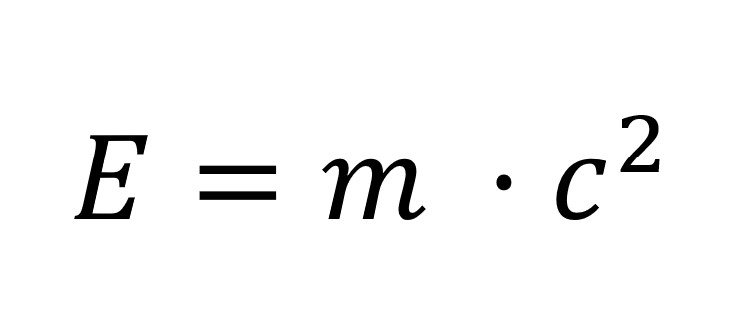We’ve been talking about creating particles but we haven’t said anything about how this is accomplished.
Particles are created when a whole bunch of energy is concentrated in one place in space. This usually occurs when two high-speed particles with a lot of energy collide.
Most of us are familiar with this famous formula for the relationship between energy and the mass of the particle:

We know we said no math but this is pretty much common knowledge these days. In case this isn’t familiar to you, E is the energy needed, m is the mass of the particle, and c is the speed of light (the little dot between the m and the c means multiply; we could leave it out for brevity and will do so below. The “2” here means multiply c times itself: we could have written c * c which means the same thing only no one writes it that way because math is a shorthand and prizes economy of expression.)
Anyway, the formula is not the critical thing here: it’s the fact that what we need is energy to make the particle that we really care about.
The reason this is so important is that when a particle like a proton does collide with another particle and undergoes the reverse transformation, back into energy, it doesn’t break up into a whole bunch of fragments as you might expect. Inside the proton are only a few tiny particles called quarks, which make up about 0.5% (1/2 of one percent) of its mass. The rest is just energy: there is nothing else inside!
This has been known for over half a century but it is only now that The New Physics can explain what is going on here.
Now, think about our formula, E = mc2. Why should the amount of energy needed to create a particle have anything at all do do with the speed of light, c? Well, remember that the speed of light in a material depends on the permittivity of the material. You may recall that the permittivity is the ability of the material to store energy from an electrical wave passing through it.
Similarly, the speed of light depends on the permeability of the material. We didn’t bring this up previously because we were comparing the speed of light in transparent materials, and all transparent materials have almost exactly the same permeability as space does.
The arithmetic relationship between the speed of light c and the permeability, represented by the Greek letter mu (pronounced myoo but looks like a “u”) and the permittivity, represented by the Greek letter epsilon, is:

Substituting the c2 with the expression on the right, above, makes the E = mc2 formula the same as

If we multiply both sides by με and switch the m to the left and the resulting Eμε to the right, we get the delightful:

Since the mu is pronounced like an “m”, it’s not too big a leap to imagine that this spells “meme”. Spread the word! This is the grandfather of all memes because it is the genesis of all matter, light and radiation in the Universe, and therefore of all other memes as well.
The speed of light c in the famous formula E=mc2 is only a placeholder for the type of material that space is, as represented by its permeability and permittivity. So, we see that the energy we need to create a particle is not related in any way to the type of material the particle might be made of, but only to the type of material that space is. This is supported by the fact that when a proton breaks up, 99.5% of its energy is immediately returned instead of it breaking up into proton fragments.
The second hypothesis of The New Physics is that when a particle is created it forms a bubble in space. It is not filled with “mass”, except for the little bit of quark matter. The evidence for this is when the proton disintegrates there is no “mass” to be found except for those little quarks, which weigh a very small fraction of the mass of the proton. (The quarks are tiny but they play a very important role; we’ll get to that soon.)
Ignoring those quarks, what’s inside this bubble? Nothing. Not even space!
There is some interesting evidence that particles might be bubbles. Physicists have been trying to measure how round the electron is because some theoretical models have predicted it must be slightly distorted. Unfortunately for those predictions, physicists have shown that if the electron were as large as the solar system, it would be round to the thickness of a human hair! And it is easier for a bubble in space to be perfectly round than for a particle made of “matter”.